#japanese cultural tidbits
Explore tagged Tumblr posts
Text
The Importance of Amae in My Personal Weatherman
Masterlist || Language Analysis Part 1
I have seen a lot of discourse in the English-speaking fandom surrounding Segasaki's apparent dismissal or trivializing of Yoh's desire to pursue his manga, and most of it is negative. His comments about wanting Yoh to remain dependent on him, or that Yoh does not need to earn money are seen as patronizing or controlling at best and oppressive at worst. It appears that Segasaki does not understand nor respect Yoh's need for independence, and that is what strains their relationship.
But what if I asked you to consider that Segasaki's behaviour is actually an invitation to Yoh to reinforce their relationship? And what if I told you that Yoh's withdrawal from Segasaki constitutes a rejection of that invitation, and it is that rejection that strains their relationship instead?
Of course, the end result is the same - a strained relationship - and in reality there is never one side wholly responsible for this. The point of this is to simply challenge the cultural notion that a successful relationship is the coming together of two equally independent individuals, as opposed to the co-creation of a relationship formed by two interdependent individuals.
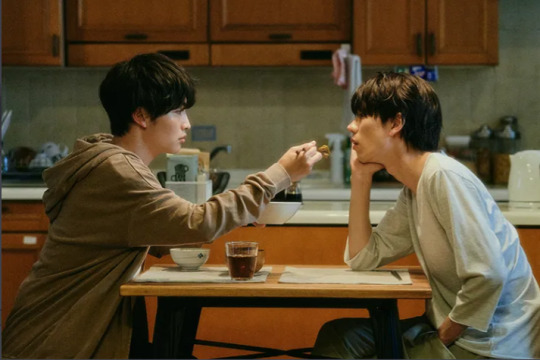
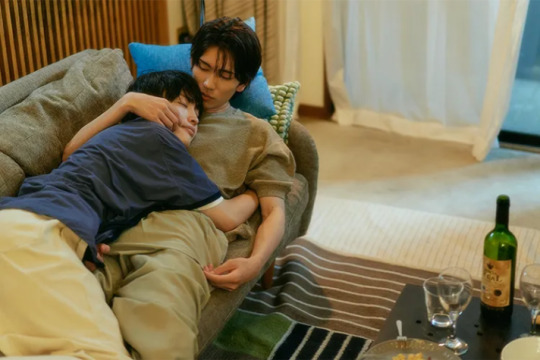
"If only you could stay drunk forever..." "It's okay to feel down again for me too you know" - Segasaki, Ep 4, Ep 5
This isn't about Segasaki wanting to keep Yoh is helpless and dependent on him, but about wanting Yoh to be able to be true to his feelings and express his own desire for affection honestly, without having to hide behind "I hate you" or rejection.
Or, let's try and talk about how Segasaki and Yoh reinforce their relationship through the use of amae (featuring a brief mention of tatemae/honne) who am I kidding this is not brief at all
First: Cultural Context
The way people conceptualize and make meaning of the Self differs between Western and East Asian cultures, and this plays into the differences we see in the basis for our self-esteem, the personal attributes that we value, and even what constitutes the behavior of a mature individual. Broadly speaking, Western cultures tend towards the Independent Self Construal (whereby the Self is a distinct entity separate from others) whereas East Asian cultures tend towards Interdependent Self-Construal (whereby the Self is connected to and defined by relationships with others). Thus, in the West, expressing one's individuality is very important for one's self-esteem, and being able to communicate clearly and confidently is valued and a sign of maturity. Conversely, in the East, one's ability to integrate and become a member of the group is prized, and contributes significantly to one's self esteem. In order to be seen as a mature individual, one must learn not only to read a social situation but also how to modify one's behavior in order to respond to the changing demands of that situation, with the ultimate goal being to maintain group harmony.
tl;dr - In East Asian culture, behaviors and attitudes that emphasize interdependence and promote group harmony actually play a big role in reinforcing relationships and one's membership towards the group.
Segasaki is an expert at this - his "public mode" that Yoh refers to actually shows us how good he is at social interactions. This is the Japanese concept of tatemae/honne (crudely translated as public self/private feelings) - which I could link to a bunch of articles for you, but I'm going to suggest you check out this 9 min street interview instead. At 6:41, one of the interviewees comments that another is sunao, or "honest" (we'll cover this later too) and at 6:49 specifically talks about how reading situations is important as an adult. Segasaki reads the room well, but most importantly, he reads Yoh well.
Yoh is not good at this, at all. In Ep 6, we see that he does not integrate well with the group, and he doesn't realize how he might appear to others when he stares and sketches from afar. Yoh does not read the room well because he doesn't pick up on social cues and does not adhere to social norms (I'll point these out in Ep 6's corrections). He cannot read Segasaki, and especially cannot read Segasaki's amae, or his attempts at reinforcing their relationship. Part of this is because his low self-esteem causes him to withdraw from Segasaki's affection as a means of self-protection, and so he valiantly tries to deny his feelings for Segasaki. As Man-san commented in Ep 4, Yoh is not sunao - he has difficulty with being true/honest about his feelings, even to himself.
Sunao is another term that usually pops up when talking about feelings/relationships. It can be used to describe one's relationship with oneself, as well as the relationship with another/group. With oneself, it is usually used to mean "being honest/truthful/straightforward/frank/open-minded about one's feelings". With another person/group, it is usually used to mean "to cooperate/listen/be obedient, or "to be humble/open-minded". In essence, the word encompasses an ideal virtue that is often taught from early childhood - that we should treat both ourselves and others with humility and honesty, because that is how we accept ourselves and stay in harmony with other. This is what becoming an adult, or gaining maturity, means (not gaining independence, as adulthood is often equated to in the West - do you see a running theme here 😂). Of course, that's actually really hard to do, so you'll often hear children (and immature adults too) chided for "not being sunao" (this can therefore sound patronizing if you're not careful). We'll revisit this in a little bit.
Second: What is Amae?
Amae is a key component in Japanese relationships, both intimate and non-intimate. It happens every day, in a variety of different interactions, between a variety of different people. But it is often seen as strange or weird, and those unfamiliar with the concept can feel uncomfortable with it. This stems from the difference in self-construal - because independence is tied so strongly to an individual's self-image in the West, it is very hard to fathom why behavior that emphasizes interdependence could be looked upon favorably. It is telling that every possible English translation of the word "amae" carries a negative connotation, when in Japanese it can be both negative or positive. The original subtitles translated it as "clingy", for example. Other common translations include "dependence", "to act like a child/infant", "to act helpless", "to act spoiled", "coquettish", "seeking indulgence", "being naive" etc.
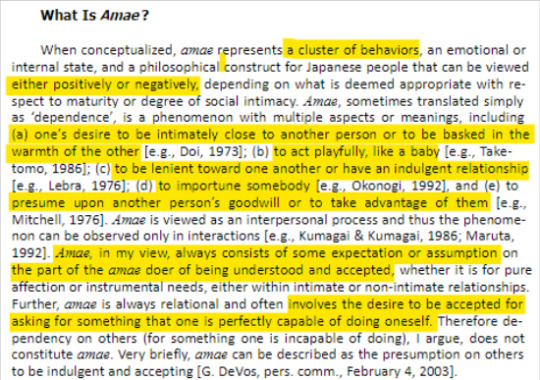
From A Multifaceted View of the Concept of Amae: Reconsidering the Indigenous Japanese Concept of Relatedness by Kazuko Y Behrens
*Note - the word "presumed" or "presumption" or "expectation" or "assumption" used in the above definition and in the rest of this post, can give the impression that all of amae is premeditated, which adds a calculative component to this concept. Whilst amae can indeed be used in a manipulative manner (benign or otherwise), it is not the case for every single situation, and often amae that seeks affection is often spontaneous and without thought, precisely because the situation allows for it to appear organically. This is the amae that Segasaki and Yoh most often exchange - so think of these assumptions and expectations as "unconscious/subconscious" thought processes.
Third: Amae Between Segasaki and Yoh
Yoh shows a lot of amae when he is drunk:


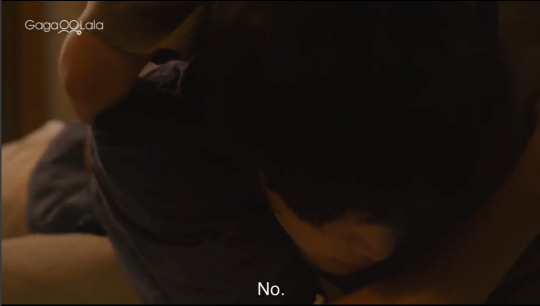
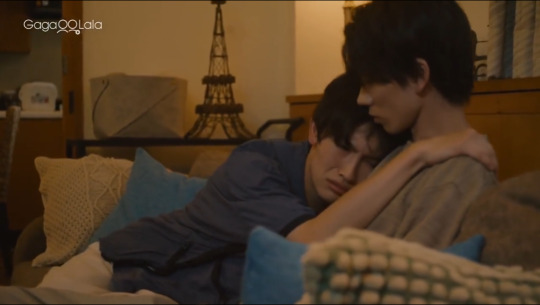
He whines, buries himself into Segasaki's embrace, refuses to move or let go of him, and keeps repeating "no". In these interactions, Yoh wants Segasaki's affection, but instead of asking, he does, well, this, and he presumes that Segasaki will indulge his behavior. Leaving to get some fresh air might not be as obvious - but it is a form of amae as well, because Man-san is his guest, not Segasaki's, and he shouldn't be leaving Segasaki to entertain her. The expectation that this is okay, and that neither of them will fault him for it, is what makes it amae.
Segasaki obviously enjoys indulging Yoh when Yoh does amae, because he recognises this as Yoh's request for affection from him. It's not that Segasaki enjoys Yoh in this drunk, helpless state; it's not even that Segasaki feels reassured by Yoh's requests for affection. Segasaki knows Yoh likes him, and recognizes that Yoh is struggling with those feelings. That Yoh is actually able to do amae to Segasaki is what delights him the most, because it is something that requires a lot of trust in Segasaki and a willingness to be vulnerable in front of him. This is how amae reinforces relationships - when a request for amae is granted, both the giver and the receiver experience pleasant feelings.
That said, an amae request can also be perceived negatively - if amae is excessive, or if the person responding feels they are obligated to do so. In Ep 5, Man-san chides Yoh for his amae - the fact that he expected to do well from the beginning, and became upset when he failed. He told her about his unemployment, presuming that she would comfort him, but alas.
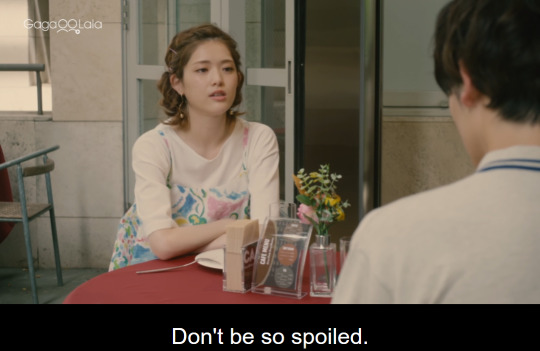
Segasaki also does amae - but unfortunately Yoh misses many of his cues, and so neither of them really gain pleasant feelings from the interaction (ok so maybe Segasaki does, but I will argue that is more because Segasaki also enjoys it when Yoh obeys him - see @lutawolf's posts for the D/s perspective on this!).
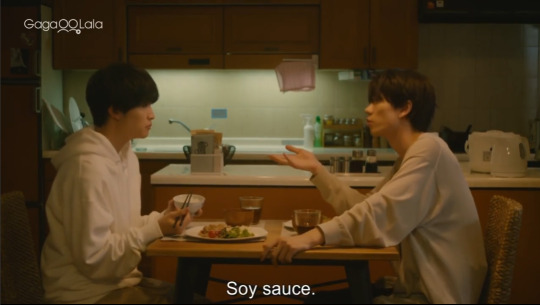


Did you catch it? Segasaki wants Yoh to pass him the Soy Sauce, which, clearly, he is capable of getting himself. He tells Yoh to feed him, because he wants Yoh's affection. And the real kicker - he asked for curry, and expected Yoh to know he wanted pork. In all these interactions, Segasaki presumes that Yoh will indulge him and do for him things he can do himself perfectly well (and even better at that) - this is what makes this amae. But look at Yoh's reactions:


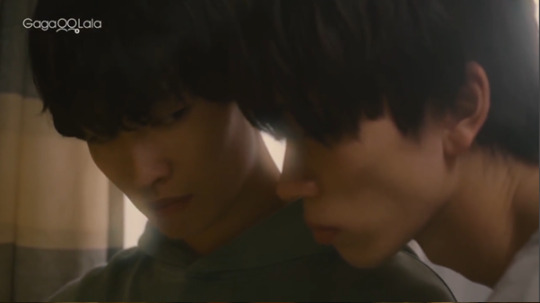
Yoh just stares between the Soy Sauce and Segasaki, between Segasaki and his food, and then just at Segasaki himself. He doesn't recognise any of this as amae, and in the case of feeding Segasaki makes the conclusion that this is somehow a new slave duty he's acquired. And therefore, he does not gain pleasant feelings from it.
In Ep 3 we see a turning point in Yoh's behaviour - his first (sober) attempt at amae (the argument in Ep 2 is debatable - it's not amae from Yoh's POV, but Segasaki responds as if it were, with a head pat and a "when you get drunk, you talk a lot don't you?").
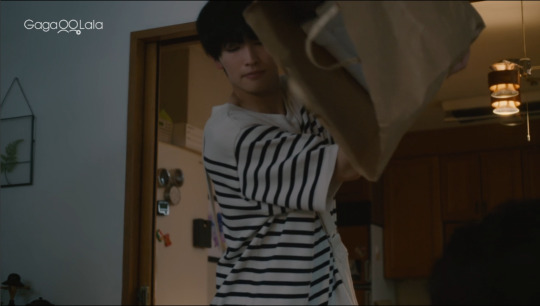
Here, Yoh wants to express his desire for Segasaki's affection, but he can't bring himself to say it aloud. Instead, he dumps bedsheets on Segasaki's lap, as if the bigger the scene he makes the greater the intensity of his desire he can convey. It is the presumption that Segasaki will understand him that makes this amae. And then, we get this:

Not only a happy Segasaki and a sweetly shy Yoh, but also a Yoh who's emboldened by Segasaki's response, and who finally, for the first time, reciprocates touch, and considers the possibility that Segasaki might actually like him.
With every episode, Yoh gets more and more comfortable with doing amae towards Segasaki, because Segasaki picks up on his cues and always responds to them. In Ep 5, Yoh's amae comes out naturally, triggered by the stress of his unemployment, and we see it in all those moments he sounds and acts like a child, and as I mentioned, Segasaki spends the whole episode reassuring Yoh that his amae is welcomed, and that Segasaki likes responding to it. If you've been wondering why the relationship between Segasaki and Yoh can, at times, feel somewhat parental in nature - this is it. It's because Segasaki sees the contradiction between Yoh's childlike insistence that he does not like Segasaki and his desire for Segasaki's attention and affection, for what it really is - Yoh's struggle with accepting himself. When Yoh is able to be sunao, he does amae naturally, and Segasaki responds to him in kind.
Now, all we need is for Yoh to recognize when Segasaki does amae, which will likely happen soon, given that Yoh has grown with every episode.
As always, thank you for reading :))
#my personal weatherman#taikan yohou#体感予報#segasaki x yoh#MPW language analysis#sociolinguistics#japanese language#japanese cultural tidbits#mytranslations#MPW subtitle corrections#my meta is creeping into my sub corrections#need to get it out here instead#sorry for the length#tbh posting such crazy long posts and expecting that people will actually read it#can be considered amae too 🤣🤣#Ep 6 corrections will be out next#I just needed to get this out before 7#and i sorta made it
509 notes
·
View notes
Text



Dungeon Meshi Bangkok AU
A very self serving au made by me for me, it’s quite hard to translate because the references I used here are very specific (unless you’re ver familiar with Thai culture I guess)
Here’s some tidbits ~
1. Izutsumi and Tade in thai highschool uniform. (I used to wear it and thought it’s not as cute as Japanese or Korean uniform, but now it’s apparently famous among Chinese tourists? You can rent a uniform if you visit bkk i think)
2. Buddha amulet collecting is a very stereotypical old man hobby here so I think it’s fun if Chilchuck is into that. People here believe that you cannot own a charm, statue or amulet which have a Buddhist connection since they will eventually be back to its holy place (temple), so they use the word rent instead.
3. Cook to order restaurant is basically a small restaurant, sometimes just a cart on a pavement with some table and chairs, that make quick local meals like pad kaprow.
4. Rice soup is just one of my favorite comfort dish, nothing important lol. But there are some restaurants making rice soup late at night for drunk people to have a hot meal.
#dungeon meshi#delicious in dungeon#dungeon meshi fanart#izutsumi#chilchuck#senshi#dungeon meshi bangkok au#tade dungeon meshi#izutsumi dungeon meshi#chilshi#???#kind of#they are in my heart#my art
8K notes
·
View notes
Note
hello!! lately i've been thinking about houses/interiors in splatoon as i've been pondering some up for my ocs, & i was wondering if there's any info on them in canon? so far the best that comes to mind is the splat 1 loading screen & that new art of acht, but I was curious on if there's anything about apartments & interiors specifically... tysm! :-]
Unfortunately we don't have much, and considering how much living spaces vary in real life even within the same culture, it's hard to say x thing applies to all splatoon households. the game developers are japanese, the game takes place in japan, and takes inspiration from japanese culture and daily life. taking that into consideration, where canon fails, i use modern japanese living spaces as a reference for imagining what an interior may look like in inkadia. headcanon aside. time to dig up what canon info i've found regarding homes and living spaces
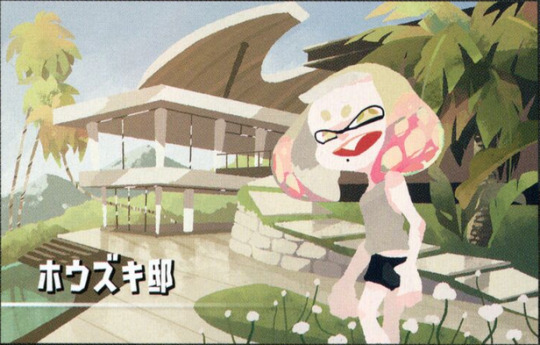
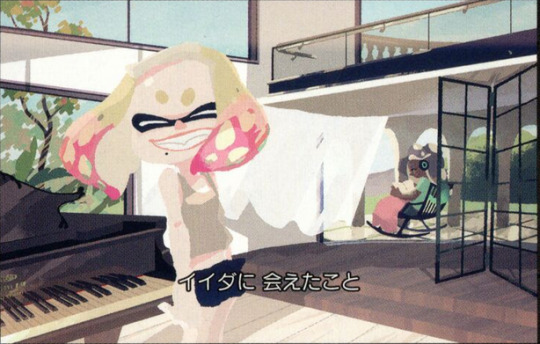


In the Octotune album booklet we get one of the few examples of an inkling home interior, the Houzuki mansion. though pearl, as well all know, is Insanely Fucking Rich and our average inkling is NOT going to be living this luxuriously. one useful tidbit we can get from the text is this:
Q5: Wow! Is this the garage? Pearl: That's just the shoe storage, man.
the word she's using for shoe storage is ゲタばこ which is a cubby you're meant to put your shoes in before entering a house, located in an entryway. in other words, implying a cultural norm of taking your shoes off before entering (something adhered to more strictly in japan vs america). not like this is really followed in official art showing inkfish at home (except for this s1 era piece of an inkling watching tv) probs because shoes are cooler lol


let's see what else ummm bedding.


s1 and s3 dialogue for flounder heights mention futons. traditional japanese bedding typically laid out on the floor when in use, and folded up and put away in a big cubby during the day. its a common sight to see them hung out in the sun on the balcony to not get moldy. some of those things draped over the railings in flounder heights are futons.

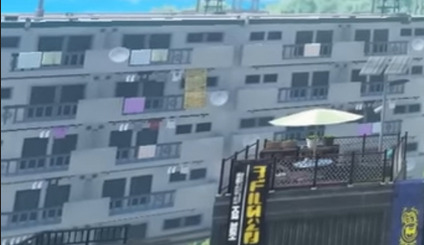
not everyone in japan does this though- youll still see western style beds or even futons on bed frames since taking it out and putting it away is a pain in the ass. also not every apartment has a built in proper futon storage space. (...mine does, but i repurposed it into another closet and just use western style bedding lol)
same is true for inkadians too -the bed in the s1 splashscreen doesnt look like a futon to me. point is there's options for what do with the bed situation.
speaking of the apartment splashscreen for s1, there is a blurb in the artbook about it and how inklings are typically pretty tidy with their living spaces.


im sure there's plenty of messy inklings too. anyway there's just a few tidbits about living spaces in relation to canon info. unfortunately there's Nothing about the bathroom or how they bathe, though previously i shared my headcanons about how i think that could work. for the kitchen i think all we can do is assume. Acht has a fridge how surprising /s at the start i mentioned that i take inspo from japanese life where canon fails. ive spent a few years in japan so this works conveniently for me LOL but i assume most people following me do not have that experience. so for those who wanna take that japan inspo too, here's a few small things that are different in japanese living spaces that ive thought may be true for inkopolis? -living spaces are so much smaller on average (of course) -washing machines do not use heated water and like Nobody has a drier in their house. laundry is hung on the balcony, or by the window if there is none, to dry. you want a drying machine? go to the laundromat. -big ovens? like for baking? casseroles? this is Rare in japanese homes. more likely youll see like a little toaster oven. microwaves with an oven setting. i have a gas stove with a fish grill drawer like this. ive never seen this in america but i KNOW in my heart inklings would have this -tiniest fucking kitchens sometimes. a pattern ive often seen for little one room apartments is a pathetic kitchen space in the hall between the entrance and bedtoom where its like. one sink. and space for an electric burner. you want counter space go fuck yourself. if youre a broke inkling who doesnt cook much this may be the option for you. -i think every house ive been in has had a genkan in some form.
155 notes
·
View notes
Note
I'm having. So many Uchiha Houhua thoughts. Like I know so much of his existence is geared towards survival but. The hc of Uchiha's use of war fans,I have to wonder if he ever finds him half heartedly fiddling with a delicate seeming Tessen, remebering an old friend now far gone, just as razor edged and yet still missed.
And it may be my own fondness for the concept of a spider summons but so much of spider behavior is "Please Leave Me Alone" which is very on brand for Houhua. Camouflage and careful, delicate and yet still so dangerous, setting invisible webs between leaves and waiting for the worse predators to pass. (Also using spider venom to fuck with his heartrate for the possum jutsu maybe?)
The entire concept is so delightful and I'm very thankful to have seen all your little tidbits on it
YOU!!!!!!!!!!!!!!!!!!!!!!!!!! YOU SENT ME A STRAWPAGE I JUST SAW IT LAST NIGHT BUT FELL ASLEEP BEFORE I COULD COPY PASTE IT TO REPLY TO HERE!!!!!!!!!!!
Omg hi funny seeing you here (<- batting my eyelashes, twirling my hair)
Anyways I love this, actually. Like, a lot.
Ough,, Houhua unable to look at war fans without thinking about both SY and SQQ,,,
I think it's actually especially fun to think ab like. The difference in fighting style between (Japanese) Uchiha styled war fan techniques and (Chinese) Cang Qiong Sect war fan techniques. Not even counting the much more specific Qing Jing Peak style of fan techniques.
That also goes double for sword techniques, especially considering the plans for Houhua to go into sword smithing.
Houhua has literal decades of the Cang Qiong sect sword style engraved into his fucking bones. Into his soul, even, if you consider the whole 'cultivators swords are usually tied to their spirits in some way' thing.
He's going to have the worst time trying to switch to Uchiha sword styles-- though I think the sharingan + the unfamiliar, tiny body without all the muscle memory of his past life will help him at least get his footing
,, Hey, is muscle memory held in the actual muscle or is it held in the brain? That's a thought.
ALSO. THE SPIDERS.
I. I cant lie to u, you are making an amazing argument rn for him having a spider summons. I love the idea sm, I am now faced w the ultimate dilemma of choosing between a spider contract or a rat contract.
On one hand, they both carry undertones of like 'there might be a bit more to see here than just a coward' bc of the associated (mostly negative) connotations of rats and spiders both being like, underhanded, sneaky, that sort of thing. But the spider tho,,, ough,, it also shows a side of implied manipulation that might be fun just from the angle of like.
Yeah you'd expect him to have some sort of rodent contract but hes actually been designated spider coded by the universe, actually.
I forget if I posted this snippet yet or if I only posted it on the discord but take this really quick:
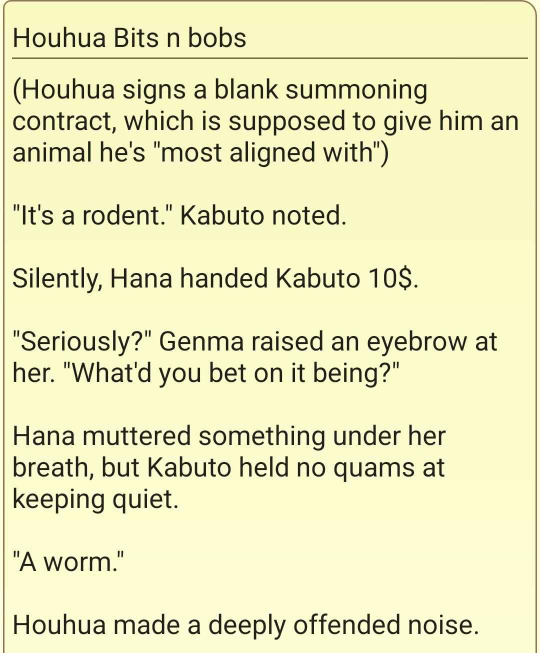
So like. This moment, where Kabuto bets Houhua will get some form of rodent contract (for obvious reasons) while Hana bets he gets a fucking worm. But now make it even funnier bc they're both wrong and he got a spider contract.
This could also maybe play interesting into Houhua and Kabuto's sort of ongoing quiet squinting in eachothers direction as they both go 'this guy isnt as simple as he seems...' as Kabuto mentally recalculates some of Houhua's behavior
This also can just bring out a pretty fun "hey so lets talk about in universe stereotypes and associations when it comes to summoning animals" which I just think is fun. Like, culturally, what does it mean to have a contracted animal? Do some people treat it like they might astrology personality tests? Do some people think its just nonsense and pure luck or not that deep?
For some people it probably isn't that deep, while for others (specifically those who might come from families who always have the same contract, or others who sign blank contracts where they really are sent to an animal that matches them best) it really is a good way to try and analyze them
And like. Where does that leave Houhua?
This could also just be fun for when he interacts w Orochimaru, who fucking hates bugs (insert my own personal favorite hc here that he hates them largely in part due to the many times he was stuck inside his own rotting body, infested with bugs)
And like, Houhua and Orochimaru will inevitably interact, though I'm not 100% sure on how it goes just yet. But like. Houhua having a spider contract and Orochimaru coincidentally hating spiders. Could be funny.
PLUS YOU'RE SO RIGHT FOR LIKE. SPIDER VENOM POSSIBLY PLAYING INTO HIS PLAYING DEAD ACT. UR SO SMART FOR THAT.
Anyways. Yeah ok I think spider contract Houhua would go pretty hard for multiple reasons. Give him a big fluffy spider with big ol eyes.
Houhua can maybe get another contract further down the line and then get the rodents he deserves.
Im so glad that you've been enjoying the SQH in naruto au nonsense I've been pumping out!! I'm like. Halfwayish done with chapter one but it keeps getting longer. I'll get there eventually.
I really need to update my tumblr vault with all the recent additions to the au but want to update it when I post the actual fic so I can link the fic to the chapter, so I'm holding off on that
Anyways, thank you for your ask!!
#uchiha houhua#svsss#sqh#shang qinghua#naruto#scum villain self saving system#crossover#birds asks#birds fic talk#orochimaru#kabuto#kabuto yakushi#yakushi kabuto#inuzuka hana#hana inuzuka#team 7 and a half
61 notes
·
View notes
Text
Tidbits about Sledge from China Marine:
He had a horse- mentions it in a throwaway line
couldn't shoot a dangerous dog because he was a "sentimental dog-lover" in his words (honestly same)
loved Mozart and other classical music
Loved philosophy
Loved history- look this man's a nerd, he was more interested in the historical sites of Beijing like the Forbidden City than all the other guys who focused on women and drinking (good for him honestly lol- probably better that way tbh too)
Was not a party guy- getting those vibes, introvert maybe?
hated vodka
Was not a drinker- his dad schooled him early about the problems with that, so Sledge to his admission, only really had like a beer or two at most usually
Went to a party out of spite/to prove he was right
Got sepsis from the sores on his fingers- he got better tho, but did have to wear a sling
Kinda a prankster honestly on two occasions with some buds
learned a bit of Chinese from a guy called How (hope I'm spelling it right) who was a paid houseboy for the Marines- he was Sledge's age, and was better with learning English than Sledge learning Chinese- they became friends and How showed him all the cool historical spots
Loved Chinese food- like all the Marines, tried to eat at local restaurants instead of the sea rations/gallery/shitty cafeteria food they were given on barracks- honestly I'd do the same. They even recruited a guy who got leave to bring back like boxes of takeout just to avoid the food if they couldn't leave the garrison.
has some beef with rear echelon guys- not unique between combat vets and non-combat guys
Interested in learning about other cultures- he became good friends with Dr. Song- a chinese doctor who was head of a hospital in Beijing- and the Song family, plus their resident Catholic priest, Father Marcell.
Was apparently a really fun professor post-war, he took his students on birdwatching walks as part of his classes- would have loved to see him on Rate My Professor
Huge nature nerd- could always name birds, plants, insects etc he saw- ended up taking birdwatching after the war.
Got offered tea by a captured japanese officer- what a wild trip that must've been.
Got accidently reported missing at one point on Pelelui- nearly gave his parents a heart attack- they literally aged with worrying about their sons in combat
had beef about people complaining about 'minor' things compared to his time in combat- something shared by other of his buds
his dad called him Fritz- also had a pep talk about him not getting bitter like in point 20, avoiding alcohol
has beef w/jocks- gets respect from former bullies? due to combat experience.
He met his wife at a friend's wedding (she was a bridesmaid) and they so infatuated by each other they could barely concentrate on wedding duties- funny but sweet.
became a good shot at dove hunting because he didn't want to make the dove suffer, just one clean kill or nothing pre-war
got his bachelors in business and sold insurance for a bit before realizing bio/nature was his thing lol
got his phd in zoology in 62- go you sledge
#the pacific#eugene sledge#he's an animal lover alright#and a nerd and a bit of a prankster#who is just a bit petty#but we love him anyway#need to see this man's stats on rate my professor#internet came too late I guess
41 notes
·
View notes
Text
what if i told you that thea’s raven number - 14 - is an unlucky number because, translated, it sounds similar to ‘must die’/‘will certainly die’ in cantonese, and ‘is dead’/‘will be dead’ in mandarin.
‘her number was 14 for reasons’ - nora sakavic, aftg extra content
what if i suggested that tetsuji gave her that number specifically because he considered a black woman dominating his own sport a threat not only to himself but to his perfect court. not only is tetsuji’s misogyny pretty clear, but we all know the other ravens were killing themselves trying to be given the next perfect court number, but that was never gonna happen because even though the perfect court was actually full of the best players, it was never actually about championing the best players, it was about ownership. so what if i said that tetsuji hated that thea was as good as she was without having any ties to himself, outside of signing on to the college team he coaches. he felt undermined because he couldn’t fully credit himself for her skill, and so he gave her the 14 - on the surface, it’s an achievement to get so close to single digits for the ravens BUT it comes with a hidden threat. you will die if you go too far.
and then what if i suggested that nora also chose 14 because of the way the fandom reacted to thea. i have no idea whether she’d already picked out the number before the series was published but i don’t think it’s mentioned in the original series ?? so i mean…
yes, i’ve seen the list of issues people have with thea but what’s crazy to me is that we know literally nothing about her bar the few tidbits nora mentioned in the extra content, and the few scenes we have in the series. and i know there was probably a full backstory written for her that we never got to see bc of all the hate nora got purely for introducing her, and the subsequent reactions to literally everything we’re told about thea just makes me think that nobody actually learned anything about how people’s trauma can drastically influence how they perceive the world and how they react to things including the abuse of other people - cough. andrew and aaron cough. - her reactions to things are bound to be built off her experiences and she was literally in a cult which would completely rewire her world view so like (even what we’re told in the EC, we don’t meet her until her fifth year of edgar allan so she’s five years deep into this shit guys, and you know tetsuji was physically and mentally abusive to all the ravens u have to know that by now)—-
but anyway this post isn’t supposed to be a defence or a critique of her i just find the number 14 aligns with the way people speak about her as though she’s done something bad enough to deserve death threats, so i just hope you realise when u perpetuate that shit it’s like ur tattooing that 14 right on her face.
oh to add to that, in japanese culture the number fourteen represents imperfection, but specifically beauty found in things that are imperfect. if i say that’s a way of saying no thea isn’t perfect but that doesn’t mean she deserves to die ? what then?
bc no she’s not a perfect person and ill be the first to admit i hated that scene in tsc with jean, but are you really telling me that’s the worst thing an aftg character has ever done?? why is she being branded as the worst when she was literally in the series for like 3 pages?
and do u know what, the fact that she, post graduation, still wears her 14 is 1) a sign of pride that she really is one of the best and 2) a reminder that she is not dead yet, despite the efforts of tetsuji and the literal fandom
#posting this with minimal encouragement bc i can’t be stopped#i don’t really care if you hate thea as long as ur aware morality isn’t black and white especially for abused characters#and just bc you don’t see her abused doesn’t mean she wasn’t#if ur going to act as tho she’s an abuser u can leave tho#aftg number analysis#numbers strike again#or i strike again with numbers i should say#thea muldani#the perfect court#aftg#tsc
75 notes
·
View notes
Text
Nerdy cultural details about the word "Hashira"
Some details can be hard to pick up without context or in translation. I recently went over a few details about the Hashira's names, Breaths, or symbols, but today I want to focus on the word "Hashira."
To get this out of the way, I use "Pillar" all over this blog because I thought that's what they were called. I was astounded that phrase was not translated, as it is a (somewhat rare) case of a one-to-one translation equivalent. They are the pillars that support the Demon Slayer Corp, after all. The kanji for it (柱) very literally means "pillar" in any modern day Japanese to English dictionary. But since you all know the word "Hashira," let's climb up and see where it takes us! First, the kanji itself (brought over from China and given the Japanese pronunciation "hashira," based on the existing spoken Japanese language), is composed of 木 for "tree" and 主 for "master" or "main/principal," among other semi-literal or more widely applicable possible meanings in modern kanji dictionaries. However, Prof. Owada Tetsuo, a retired university professor who published an unofficial book of his own Kimetsu no Yaiba interpretations based on Japanese demon slaying folklore, points out that 主 can also be interpreted as a still flame atop a candlestick, and that 柱 (hashira) is a tree that cannot be moved. (I'll continue to use a lot of Prof. Owada's details in this explanation, as well as details I have picked up in other research.) That makes 柱 closely associated with holy trees found in, or treated as, Shinto shrines throughout Japan. As Shinto is a nature-based belief system, trees are often something that a kami (deity) will inhabit. Keep Shinto in mind, because we're going to focus on that a lot.
Before that, let's finish up with the kanji 柱. According to the first official fanbook, there is an upper limit of nine Hashira because there are nine strokes in the 柱 kanji. (See this dictionary entry for a breakdown of those nine strokes.)
Now that the easy official tidbit is out of the way, back to the Shinto fun stuff and conjecture! We need to dive a bit more into the spoken Japanese language, from which a lot of Shinto terms derive. For starters, the Japanese language uses counter words for when you say a certain number of beings or objects. You could think of this as "a sheet of paper" or "three rolls of tape." It is an annoying part of starting out your study of the language because there are a lot to memorize based on sizes, shapes, types of animals, etc. Deities also have their own counter word: 柱 (hashira). This goes to show how the Hashira of the Demon Slayer Corp are something more than human, what with how much power they possess.
Now if we think about the pronunciation of the spoken Japanese word from long before a Chinese written character was assigned to it, the "hashi" of "hashira" is a "bridge." Clever ones among you might know that "hashi" also means "chopsticks." But even chopsticks have the same effect as a bridge! They serve as a connection, bridging the gap between you and what was another living thing, that which will become a part of you as your sustenance. "Hashira," as pillars, are likewise something that serve as a connection, in this case, a vertical one. They are that which connect us with the heavens, or in the case of the Demon Slayer Corp, they bridge the gap between the limits of human strength and the inhuman strength of demons.
As another Shinto tie, one of the connections that Prof. Owada and I both made was that there are nine pillars that support the main sanctuary in shrine architecture like that of Izumo Taisha Grand Shrine. Or rather, in the case of at least one of the historical iterations of Izumo Taisha, there were nine groups of three massive tree trunks each, resulting in a shrine over 48 meters in height (see here for photos of how big the remains of those pillars are and how exciting the archaeology is). These pillars give you a sense of awe for just how powerful pillars can be, especially when you have a spread of nine to distribute the weight. Now, there's more that Prof. Owada and I would both say about how Izumo Taisha also ties in with the "Ubuyashiki" surname or the "yakata" title by which the Hashira address him, but that's a dose of nerdery for some other time.
#kny nerdery#kny reference#kny references#I forget which tag and I'm sticking it in there for the official fanbook bit#otherwise this is what My Research makes possible#thank you My Research#and thank you Prof. Owada's Research even though I think you're stretching too far to make connections#for the sake of talking about other nerdy folklore stuff in a KnY themed book
136 notes
·
View notes
Text
SaneGiyuu Argument 2 - 'But they have descendants!'
This is another point antis love to make against the SaneGiyuu ship and it's true after all, it's in the last chapter of the manga so yeah it's canon, they have biological descendants....or do they?
I'd like to thank the lovely angel who added this little tidbit of info in the Demon Slayer Tv tropes page. Whoever you are I love you! 😘

So I did a little research and it turns out the concept of descendants in Japanese culture are vastly different from that of ours in the west.
There's this thing called Adult Adoption.
It's a practice where an adult is 'adopted' into the family as their offspring legally and socially. It's a way of preserving the family name and artifacts and stuff.
It's still being practiced today even by family owners of mega corporations.
It's a really common practice:
So it's very possible that Giyuu and Sanemi's descendants aren't biologically related to them. They probably passed on their name and stuff to one of the junior slayers who admired them lots.
Plus, they only have four years left and they aren't the kind of guys to just speedrun their marriage only to then abandon their families when they die, especially Sanemi.
'But Giyuu had a wife-'

There's nowhere in the canon material that a wife is mentioned. It's probably some AO3 story that some asshole passed off as canon like Obanai wanting to propose to Mitsuri with a ring. There is no wife!
But okay, even if their descendants are biologically related to them for some reason, people be acting like queer men can't have kids too 🙄.
In Conclusion, this argument can kiss my ass!
#demon slayer#kimetsu no yaiba#kny#giyuu tomioka#sanemi shinazugawa#sanegiyuu#sanemi x giyuu#kny spoilers#unhinged yap
55 notes
·
View notes
Text

I’m old enough to remember when anime English subs would add a little tidbit about Japanese culture so the full context of the Japanese language would be translated across cultures as much as possible.
I think this would have been a lot helpful with the chihuahua joke during Unkie Yuri’s visit:




34 notes
·
View notes
Text
KH4 First Trailer

This is the first KH4-related translation post I've done (nearly two years late ;lakjsdf my how the time flies), and hopefully there will be many more to come. I'll be focusing on the dialogue and text in the trailer and not so much on the camera angles, character expressions, etc. this time around just because I want to keep the focus on the translations.
Here’s a general key for the kind of analysis I like to do:
JP: Official Japanese Dialogue
EN: Official English Dialogue
TR: My Translation (usually more literal and thus more stilted than the official English version. I’m not using natural-sounding English in order to stick as close to the Japanese versions of the lines as possible for the purpose of analysis)
Notes: things I found interesting, grammatical points, extra thoughts, etc.
One last note: media doesn’t exist in a vacuum. Every work of art must be viewed through the cultural lens of the people who made it. Kingdom Hearts, for all its ties to Disney, is still very much a Japanese game, so it should be analyzed in light of that.
With that in mind, let’s continue.
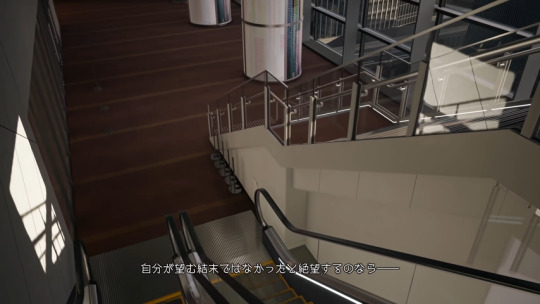
JP 自分が望む結末ではなかったと絶望するのならー
EN If this isn't the ending you desired—if it brings you despair—
TR If (this) wasn't the ending you hoped for—if (you) feel despair—
Notes: Sigurd is apparently the character saying these next few lines.
The word for "ending" here, ketsumatsu, is an interesting word choice. It is often used in the context of stories (though it also has other uses), which fits really well with how KH4 will play around with the concept of reality vs. unreality. So on a meta level it's like, "If you didn't like how KH3 ended, if you didn't like how Sora ended up, then help him escape Quadratum."
Also, the word the official English version translates as "desired," nozomu, can mean "desire, want, wish for, hope for," and it's an antonym of zetsubō, the word translated "despair." So there's this nice poetic contrast going on between hope and despair in this bit in the Japanese version.

JP 他の世界に退場すればいい
EN then leave this world for another
TR —(then you) should leave for another world.
Notes: This particular word for "leave," taijō, can be used for leaving venues, stadiums, parking lots, rooms, sports games, etc. It can also be used for actors exiting the stage. Take a look at definition #1, which translated states, "Leaving venues, stadiums etc." and #2, which translated states, "Actors etc. leaving the stage" (Source):

I thought that was really interesting, because using a word with these specific connotations makes me wonder if this is more of that meta commentary, this time about how we should direct Sora the character to leave Quadratum if we so desire. Sure, the general sense of "leave" or "exit" is the main meaning here, but I always get so intrigued by word choice and all the connotations a word has.
Also, the phrasing isn't exactly the same, but there is a euphemism in Japanese for the place your soul goes when you die, takai, that uses the same kanji as hoka no sekai that we see in "another world" here, it just uses the onyomi pronunciation instead of the kunyomi pronunciation for "another" hoka/tai and has no no particle.
Googling hoka no sekai brought up a lot of images about parallel worlds and the isekai genre, so that's probably the most accurate connotation given Sora's world traveling adventures thus far, but I still thought that was an interesting tidbit, even if it's a complete reach on my end. Like sure Sora can go to other worlds, but he's still dead, so he's still going to more places where he's dead and can't go home where he'd be fully alive.
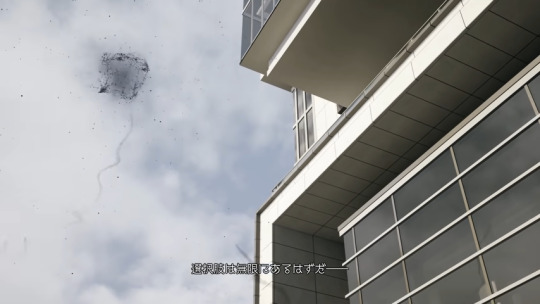
JP 選択肢は無限にあるはずだー
EN Your options are endless.
TR (Your) options/choices should be endless/limitless—
Notes: I really like how the English version contrasts "ending" with "endless." You don't like the ending Sora got in KH3? Your options for taking him to other worlds are "endless." The Japanese version has this interesting tidbit too where the speaker conveys an expectation. He says hazu, which means "expected," "should be," "must be." So he expects Sora's options are endless, but it has a slightly different nuance than if he'd just said they are endless.

JP 心は魂に宿り 魂は運命によって在るべき場所へ導かれる
EN The heart resides within the soul which in turn is guided by fate to its rightful place
TR (The) heart dwells in (the) soul, (and the) soul is guided by fate to its rightful place (lit. the place it should be).
Notes: There's not really any difference between the official English version and my translation. It's just interesting to break it down. For whatever reason the "rightful place" of the soul has the verb of existence for inanimate objects (aru) instead of the one for animate objects (iru). Not sure if that's a set phrase or if the soul in this context would be considered an inanimate object (time to go down a rabbithole about animacy in Japanese).
This bit also kinda reminded me of how Xehanort talked in KH3 when he was recounting the cycle of light and darkness. The language has a very "mythological"/storytelling feel to me, which makes sense given whoever is saying these lines is talking about fate, destiny, the nature of the universe, etc. And then the floating text in the darkness also reminds me of the Dive into the Heart sequences with the disembodied voice as well, so it could also be a reference to that.

JP 選択は再び委ねられる
EN The choice is yours once more.
TR (The) choice is left (to you) once more./(The) choice is entrusted (to you) once more.
Notes: Once again, this bit of text seems very meta. It feels like it's addressed to the fans, given how we're the ones who will be controlling Sora in KH4. And of course the image shows his chess piece with his crown symbol on it, so the implication is that Sora's heart will be the one guiding him once more, and his heart will be guided by fate.
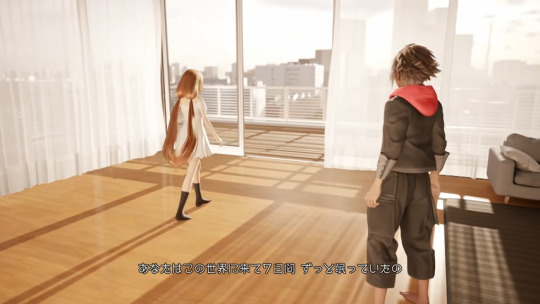
JP あなたはこの世界に来て7日間 ずっと眠っていたの
EN You've been asleep since you arrived in this world seven days ago.
TR You came to this world seven days ago (and you)'ve been sleeping (the) whole time.
Notes: I don't love my translation because nanokakan more literally means "a period of seven days," but yeah I think I get the gist across.
Strelitzia refers to Sora as anata here when the norm is to refer to other people by their names in Japanese, even when addressing them directly, so either she doesn't know his name yet or she's being very polite, almost distant. She also ends her declaration with no, likely to indicate she's offering more of an explanation (it also makes her sound pretty cute and feminine).
Also, as I'm going through this trailer again, I'm reminded that Sora doesn't talk at all. He has the battle grunts during his fight against the Darkside, but he doesn't have any dialogue. I just thought that was interesting, because Xehanort commented on Sora not having a voice in Melody of Memory as well. Somehow that also told Xehanort where Sora's heart is located (foreshadowing for this game I suppose). I wonder if Sora will be similarly voiceless at first in KH4 or if he just is for this trailer for dramatic effect because Nomura knows everyone wants to hear him speak.
And then of course I have to mention the significance of Sora being asleep in Quadratum for seven days. Seven has a lot of significance in the KH universe, given how there are seven guardians of light. Seven is also the length of a week, and it's a number that has connotations of wholeness and completion in certain cultures.
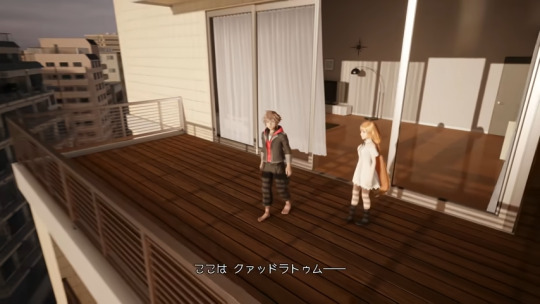
JP ここは クァッドラトゥムー
EN This is Quadratum—
TR (This is) Quadratum—
Notes: Not really anything to note here other than the gorgeous graphics, how Sora doesn't look at all like his usual cheerful self (no smile to be found), and the colors in Quadratum seem very warm/brown/earth tones/"real" and not super bright and colorful like in the "main" KH universe.
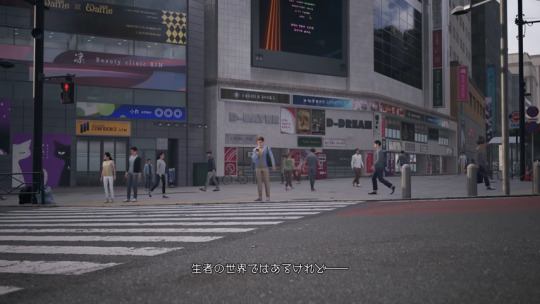
JP 生者の世界ではあるけれどー
EN It's a world full of life—
TR (It's) a world of living people/the living but—
Notes: Seija is translated as "full of life" in the official English version, but it more literally means "living people" or "the living." So Strelitzia is pointing out that all around them are living people and yet, for her and Sora, it's still a world of death because she and Sora should be dead.
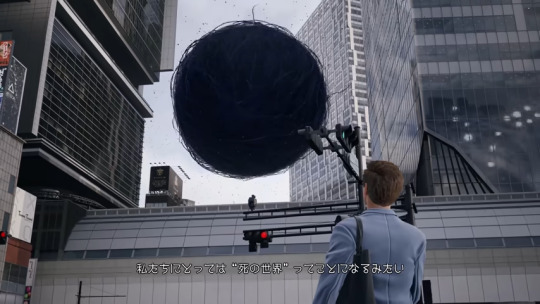
JP 私たちにとっては“死の世界”ってことになるみたい
EN but for you and I, it's similar to an "afterworld," I suppose.
TR —for us, (it) seems like it's "a world of death."
Notes: This is where I wish the English version was closer to the Japanese version. "World of death" or "world of the dead" would've been a closer translation, and I'm not sure why it wasn't used (perhaps to avoid mentioning the dreaded "d" word). I do like the pun-like quality of "afterworld," combining "afterlife" and the oft-used-in-the-KH-universe "world," and since the translators have access to information I don't about the game's lore, I can't say whether crucial lore has been lost in translation, but I wanted to point out the difference here.
Also, the grammar pattern Strelitzia uses here, koto ni naru, indicates something that's outside of her and Sora's control. This being an afterlife of sorts for the two of them was decided by factors beyond their control, in other words. She also uses mitai to indicate her speculation/observation.

JP だがー
EN However—
TR However—
Notes: This is back to Sigurd speaking, and very ominously so.
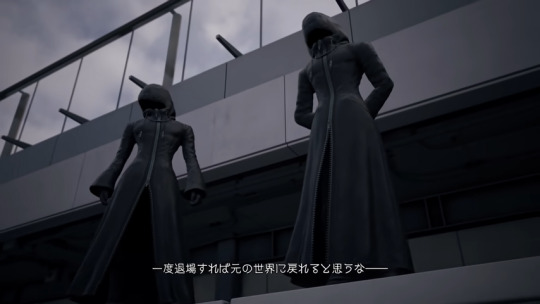
JP 一度退場すれば元の世界に戻れると思うなー
EN if you do leave this world behind, don't expect to return to the one from which you came—
TR —once (you) leave, don't think (you) can go back to (your) original world—
Notes: This ends on a rather ominous note. Again the word taijō is used here for "leave" much like earlier in the trailer. I remember this dialogue when I first watched this trailer because it was such a wham line. What do you mean Sora can't go home? He can go to other worlds but he can't go home? What will it take to bring him home then? Something pretty drastic from the sounds of it.
Also, I like the formal wording of the official English version. Sigurd sounds like he's from a different time.
Then of course this next bit cuts to Donald and Goofy, searching for ways to find Sora presumably:

JP どこにいるんだろう?
EN I wonder where he is.
TR (I) wonder where (he) is.
Notes: Nothing really to talk about, just that the "I" and "he" is implied in Japanese (Japanese tends to drop pronouns in places they would be required in English because there's enough info provided by context, verb conjugations, etc. to figure out who the speaker is talking about).
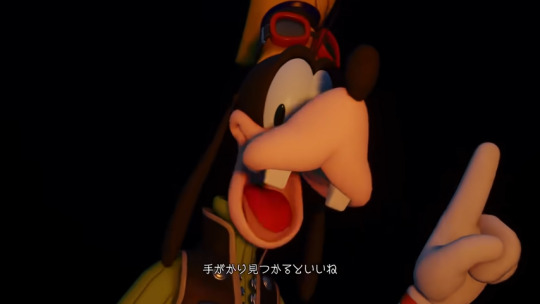
JP 手がかり見つかるといいね
EN I don't know, but I sure hope he can help.
TR I hope (we) can find (a) clue.
Notes: A bit of a difference here, Goofy is focused more on finding a clue in Japanese whereas in English he's hoping "he" (Hades, presumably) can help.

JP おい
EN Hey!
TR Hey!
Notes: Hades' Japanese VA has a very distinctive voice, and so right from this word you know it's him a;lsdkjf and he's as snarky and blunt as ever lol.

JP どこへ行くんだ
EN Just where do you think you're going?
TR (Just) where (do you think you)'re going?
Notes: I love the sass and snark of the English translation, and it captures the vibes of the Japanese version well (Hades uses ~nda at the end of the sentence to indicate he wants more information out of them). They found Hades, but now they'll actually have to deal with Hades...
And that's what I have for now! I am curious about what promo material will be released next and what new tidbits we'll have to speculate on. Fingers crossed we get more info around the anniversary this year!
The Japanese trailer is here.
The English trailer is here.
#kingdom hearts#kh#kh4#kingdom hearts 4#sora#strelitzia#kh sora#sigurd#hades#donald#donald duck#goofy#kh analysis#phoenix translates#phoenix-downer#kh4 spoilers#kingdom hearts 4 spoilers#long post
117 notes
·
View notes
Text
Consulting the convoluted history of supernatural foxes, or why is Tsukasa like that

I know I said you should only expect one long Touhou-themed research article per month, and that the next one will be focused on Ten Desires, but due to unforeseen circumstances a bonus one jumped into the queue. For this reason, you will unexpectedly have the opportunity to learn more about the historical and religious context of the belief in kuda-gitsune, or “tube foxes”, as well as their various forerunners. Tsukasa is clearly topical thanks to Unfinished Dream of All Living Ghost, and I basically skipped covering Unconnected Marketeers in 2021 save for pointing out some banal tidbits, so I hope this is a welcome surprise. The post contains spoilers for the new game, obviously.
Obviously, in order to properly cover the kuda-gitsune, it is necessary to start with a short history of foxes in Japanese culture through history, especially in esoteric Buddhism. Early history: the Chinese background Early Japanese sources pertaining to foxes show strong Chinese influence. There was an extensive preexisting system of fox beliefs to draw from in continental literature, dating back at least to the Han dynasty (note that while the well known story of Daji is set much earlier, its modern form only really goes back to the Song dynasty). This is way too complex of a topic to discuss here in full, sadly, so I will limit myself to the particularly interesting tidbits.

A multi-tailed fox in the classic Chinese encyclopedia Gujin Tushu Jicheng (wikimedia commons)
It will suffice to say that historically the fox was perceived in China as a liminal being, and could be associated with pursuits regarded as ethically dubious, ranging from theft and banditry to instigating rebellions and promoting divisive religious views (so, for example during the reigns of firmly pro-Taoist emperors, Buddhist monks could be associated with foxes). Literary texts focused on supernatural foxes emphasized their shapeshifting abilities. In contrast with some of the other well attested supernatural beings in Chinese tradition, they could take a range of human forms, appearing as men and women of virtually any age. Often they favored mimicking people who lived on the margins of society, like bandits, courtesans or migrant laborers. It was also emphasized that they displayed a considerable degree of disregard for authority. The fact these animals lived essentially alongside humans without being domesticated definitely played a role in the formation of this image.
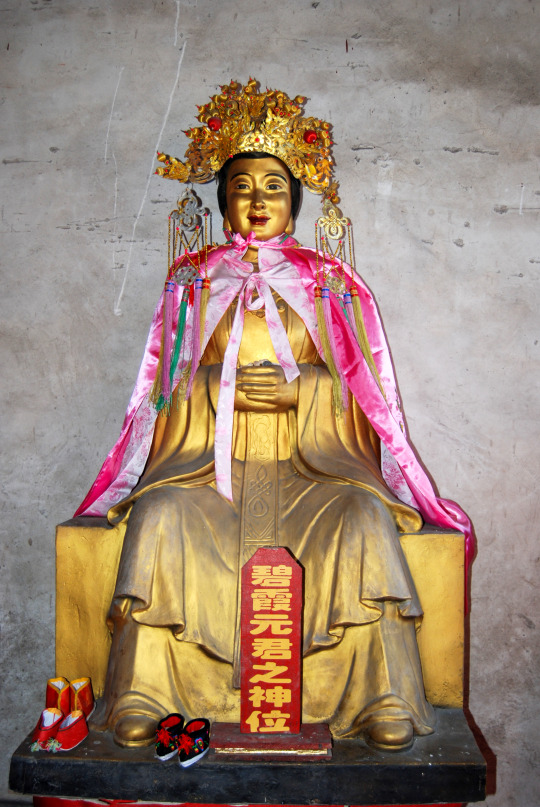
A contemporary statue of Bixia, a deity in the past associated with fox beliefs (wikimedia commons)
At the same time, foxes enjoyed a degree of popularity as objects of semi-official cult, still practiced here and there in China in modern times, for example in Boluo in Shaanxi. The religious role of foxes was reflected in, among other things, the development of terms like hushen (狐神) “fox deity”, or huxian (狐仙), “fox immortal”. The belief in such “celestial foxes” (tianhu, 天狐) was relatively common, and there is even a legend according to which there was a formalized way for the animals to transcend to higher states of existence, with the goddess Bixia making them undergo the supernatural fox version of the well known imperial examinations. If they failed they were condemned to live as “wild foxes” (yehu, 野狐) with no hope of transcendence. There are also accounts of foxes pursuing the status of a xian through illicit means, through a combination of praying to the Big Dipper and draining people’s energy, as documented by He Xiu in the 1700s. Note foxes were already portrayed as worshiping the Big Dipper during the reign of the Tang dynasty, but back then it was only believed this let them transform into humans.
The ambiguity of foxes is evident in the Japanese perception of these animals too. Supernatural foxes are probably among the best known youkai, and especially considering this is a post about Touhou I do not think the basics need to be discussed in much detail. They were believed to shapeshift and to steal vital energy, much like in China. Their positive role as messengers of Inari, a kami associated with agriculture, is generally well known too. The earliest sources documenting encounters with supernatural foxes are obviously, as expected, the earliest chronicles like the Nihon Shoki, where they mostly appear as omens. By the Heian period these animals are well established in the written record. For instance, Nakatomi Harae Kunge includes “evil magic due to heavenly and earthly foxes” among phenomena which require ritual purification. In addition to the tales imported from China being in circulation, some setsuwa written in Japan involved shape shifting foxes. However, supernatural foxes only gained greater prominence in the Japanese middle ages due to the growth of relevance of two deities they were associated with, Inari and Dakiniten. The latter is more relevant to the topic of this article.
Foxes, Dakiniten and tengu
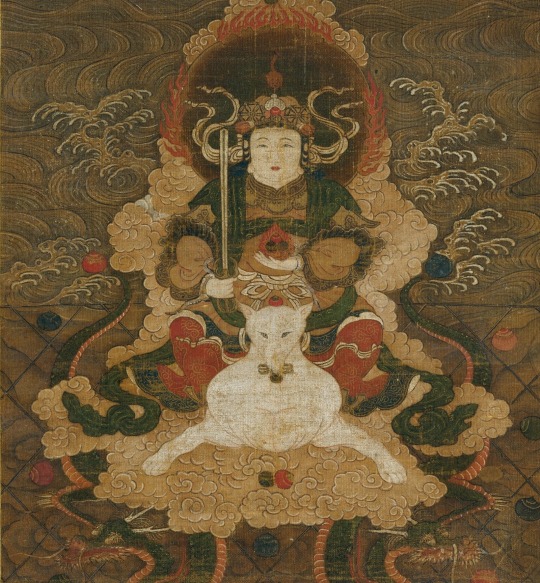
Part of a hanging scroll depicting Dakiniten riding on a fox (wikimedia commons, via MET; cropped for the ease of viewing)
The connection between foxes and Dakiniten reflected their associations with the dakinis, a class of demons in Buddhism. Originally the dakinis were associated with jackals instead, but Chinese Buddhist authors presumed that the animal mentioned in this context is basically identicial with more familiar foxes, and that belief reached Japan as well. It was strong enough for Dakinite, the dakini par excellence, to be regularly depicted riding on the back of a fox. Dakiniten was originally a regular dakini, according to Bernard Faure specifically one who appears in Heian period Enmaten mandalas (Enmaten is related to but not quite the same as the better known king Enma, for the development of two distinct reflections of Yama in Buddhism see here). However, she eventually developed into a full blown deva in her own right, and her prominence was so great that it basically resulted in the decline of references to the generic dakinis in Buddhist literature in Japan. She was particularly popular in the Shingon school of Buddhism, and at the peak of her relevance played a role in royal ascension rituals, developing a connection with Amaterasu in the process (Amaterasu acquired many peculiar connections through the Japanese middle ages, it was par the course). A Tendai treatise equates her with Matarajin instead, though. An interesting phenomenon related to Dakiniten is the occasional fusion of beliefs pertaining to foxes and tengu, which might have originated in the similarity of the terms tengu and the Japanese term for the already mentioned “heavenly foxes”, tenko. Its best attested examples include the inclusion of tengu in mandalas focused on Dakiniten as her acolytes. However, a different deity ultimately exemplifies this even better. Iizuna Gongen and "iizuna magic"

Iizuna Gongen riding on the back of a fox (Museum of Fine Arts Boston; link to the source is temporarily dead, the image is reproduced here for educational purposes only)
The indisputable center of the network of connections between foxes and tengu is Iizuna Gongen (飯綱権現), depicted as a tengu riding on a fox. As you can probably guess, he was a (vague) basis for Megumu, as evidenced by the similarity of the names. While many other aspects of his character aren’t really touched upon in the game, I’d hazard a guess he’s also the reason why ZUN decided to include a kuda-gitsune in the same game as Megumu - the evidence lines up exceptionally well, as you’ll see.
Originally Iizuna Gongen was simply the deity of Mount Iizuna (飯綱山), located in the modern Nagano prefecture. Near the end of the Japanese middle ages he spread to other areas, likely thanks to traveling shugenja (also known as yamabushi), mountain ascetics belonging to a religious tradition known as Shugendō. Two aspects of his character are particularly pronounced, his role as a martial deity and his association with foxes.
I was unable to determine when Iizuna Gongen’s connection to foxes originally developed, but it was strong enough to lead to the use of the alternate name Chira Tenko (智羅天狐; “Chira the heavenly fox”) to refer to him. Foxes also appear in a legend describing his origin. It states that he was one of the eighteen children of an Indian king, and arrived in Japan alongside nine of his siblings on the back of a white fox during the reign of emperor Kinmei (the remaining eight went to China and became monks on Mount Tiantai). His connection to foxes is also reaffirmed in an Edo period treatise, Reflections on Inari Shrine (稲荷神社考, Inari jinja kō), which declares that names such as Iizuna Gongen and Matarajin (sic!) are used in the worship of wild foxes to hide the true nature of the invoked entities. The author further states that the true form of “these matarajin (plural) and wild foxes” is that of a three-faced and six-armed deity, which curiously has more to do with early Matarajin tradition than with Iizuna Gongen as far as I can tell. The two were not really closely associated otherwise, but it’s worth noting that apparently shugenja perceived them both as similar tengu-like deities.
The key feature of conventional iconography of Iizuna Gongen, the fox mount, has nothing to do with Matarajin strictly speaking, and likely reflects the influence of Dakiniten. However, the animal in this context developed its own unique identity thanks to the presence of foxes in a type of ritual focused on Iizuna Gongen, which could itself be referred to as iizuna. The shugenja community centered on the worship of Iizuna Gongen was not very formalized, which led to poor understanding of their practice among outsiders, with the term iizuna basically acquiring the vague meaning along the lines of “magic”. and rather poor reputation. These rites are where the kuda-gitsune comes into play. Kuda-gitsune in iizuna magic and beyond

The kuda-gitsune, as depicted in Shōzan Chomon Kishū by Miyoshi Shōzan (Waseda University History Museum; reproduced here for educational purposes only)
At first glance, kuda-gitsune is just one of many local variants of the standard supernatural fox, similarly to the likes of ninko, osaki-gitsune or nogitsune. The etymology of its name is straightforward. I’m sure you can guess what the second half means, while kuda (管) in this context refers to a bamboo tube. You’d think the name would basically guarantee it was universally accepted that’s how one could carry such a critter undetected, but apparently there was an alternate explanation, namely that it was invisible. I have not seen any further discussion of this in literature, but I assume this might be connected to shikigami beliefs, as these quite often are described as invisible. Do not quote me on that, though. Even more bizarrely, there is no consensus that the animal meant was always a fox. According to Bernard Faure it is distinctly possible the term referred to a weasel. Kuda-gitsune could be described as a type of shikigami, but note that this term had a much broader meaning in real life than in Touhou, and referred to basically any supernatural being which acted as an extension of the powers attributed to “ritual specialists” (祈祷師) such as onmyōji, shugenja or Buddhist monks. In Buddhist context, the analogous term could be gohō dōji (護法童子; “Dharma-protecting lads”), though there are also cases where gohō and shikigami are contrasted with each other. The shikigami category didn’t just consist of animated papercraft and animal spirits typically designated as such in popculture. Even the twelve heavenly generals defending the “medicine Buddha” Yakushi could be labeled as shikigami. Obviously, kuda-gitsune is closer to the familiar meaning of this term than to Buddhist deities, though. People relying on kuda-gitsune were referred to as kitsune-tsukai (狐使い), which can be loosely translated as “fox tamer”, and it is said they were often shugenja. Given the popularity of the associated deity among them this shouldn’t really be a surprise. Various supernatural abilities were ascribed to the kuda-gitsune. The ability to possess people attributed to other supernatural foxes was the domain of kuda-gitsune too. Apparently people afflicted by it were compelled to eat nothing but raw miso. Purportedly they were bringers of wealth - but said wealth did not necessarily come from legitimate sources. That, in turn, could lead to distrust or outright ostracism of people allegedly relying on foxes to acquire wealth. They also provided aid in divination, and could supposedly reveal past, present and future alike this way. However, they could look into the soul of anyone using them this way and learn their secrets. Bernard Faure notes that occasionally it was said that they even could even be utilized to kill enemies who attempted casting spells on their owner. Shigeru Mizuki's kuda-gitsune
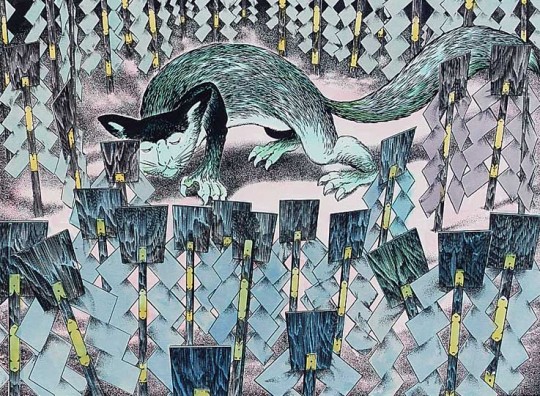
Kuda-gitsune, as depicted by Shigeru Mizuki (reproduced here for educational purposes only)
While there isn’t much information about kuda-gitsune in scholarship, especially scholarship available online in English, they received extensive coverage in various books about youkai written by Shigeru Mizuki, famous for arguably canonizing the modern concept of youkai. Note that while I am a fan of Mizuki's works, his encyclopedias are best understood as something closer to Borges’ Book of Imaginary Beings, complete with some dubious sourcing and possible fabrications. However, ultimately modern media about youkai, including Touhou, owes much to him, and arguably he continued the tradition of night parade scrolls which often invented new creatures wholesale, so it strikes me as entirely fair game to summarize what he has to say too. Shigeru Mizuki cited the Edo period writer Matsura Seizan as an authority on kuda-gitsune. He states ccording to the latter, certain ascetics (yamabushi) were provided with these critters upon finishing their training on Mount Kinpu and Mount Ōmine. In his account cited by Mizuki there are a lot of details I haven’t seen elsewhere. The storage tubes after which kuda-gitsune are named apparently had to be inscribed with a certain sanskrit phrase (left unspecified, tragically) so that the animals didn’t have to be fed. However, releasing them and giving it food was necessary to gain their help in divination. There was a downside to this - kuda-gitsune were apparently hard to place back in containment once released without the help of a seasoned specialist. Also, they refused to provide anything of value unless fed well, and they had quite the appetite. Mizuki cites the particularly disastrous case of an ascetic who kept multiple kuda-gitsune in a single tube, and eventually couldn’t pay for enough food for his collection since the animals kept multiplying inside. According to Mizuki it was believed that a kuda-gitsune could be gifted by its owner to another person, but the creature would come back if it was not satisfied with the food provided by the latter. If the original “fox tamer” dies before passing their kuda-gitsune to someone else, it will instead go to the Ōji Inari shrine located in what is now the the Kita ward of Tokyo.
Conclusion: Tsukasa and her forerunners

In theory I could’ve kept pointing out “see, it’s just like Tsukasa!” in virtually every single paragraph of this article. To answer the question from the title, evidently she is like that because that's how foxes have been in folklore both Japan and China for centuries. It is not really hard to see that ZUN is genuinely great at research when he wants to be, and Tsukasa's character is remarkably accurate to her real life forerunners, both as an adaptation of kuda-gitsune specifically and as a representation of the broader tradition which lead to the portrayal of foxes as supernatural creatures of questionable moral character. She engages in morally dubious “get rich quick schemes”, she definitely provides advice (of variable quality), and her self-declared ability from her omake bio pretty clearly reflects skills actually ascribed to the kuda-gitsune in folklore. In the newest game the ability to provide information is clearly in the spotlight - Tsukasa seems to be reasonably knowledgeable (she brings up Kojiki in a line aimed at Hisami, among other things), and other characters generally agree she’d be more useful doing something else than fighting. I do not think there’s any real reason to doubt this is what is meant. I think it can even be safely assumed that Zanmu’s decision to pressure Tsukasa to partake in her assassination bluff is rooted in genuine tradition. I’m obviously not going to say that Tsukasa reaches the platonic ideal of Okina, the quintessential character aimed at fans who like research, who largely seems to exist to get people to dig deeper for sources explaining the dozens of religious allusions in her dialogue, spell cards and design, but I do think it’s worth appreciating that the series reached a stage where even the minor animal youkai can be enjoyed as multilayered representation of centuries worth of genuine folklore and mythology. Bibliography -Bernard Faure, Gods of Medieval Japan vol. 1-3 -Michael Daniel Foster, The Book of Yokai. Mysterious Creatures of Japanese Folklore -Berthe Jansen and Nobumi Iyanaga, Dākini (Brill’s Encyclopedia of Buddhism) -Xiaofei Kang, The Cult of the Fox: Power, Gender, and Popular Religion in Late Imperial and Modern China -Shigeru Mizuki’s assorted writings on kuda-gitsune (collected online here)
356 notes
·
View notes
Note
Besides American pop culture such as metal, is Miko a fan of the more traditional aspects of Japanese culture at all?
Hmm, this is a tricky question for me because I'm a born and raised American hapa. My half-Asian is Viet.
A lot of my thoughts for Miko were formed by conversations with a few Japanese exchange students, YouTube, Japanese language classes, online information, and what I would have liked to see from the show.
I'm going to be missing a lot of cultural context from a native perspective.
(That or I'm reading way too deep into this ask lol)
I really wish that we had more instances of culture clash or misunderstandings because it could have provided more depth to everyone by opening new dialogue and provided more context of the lore and character backgrounds.
As a character, Miko Nakadai comes off more like an American-born or as someone who's very comfortable in the U.S. from long-term exposure. Perhaps she has relatives in a different state? But then that opens more questions than answers. (It doesn't matter obsessed you're into a country or culture, the first hand experience is a shock.)
And it doesn't help she feels slap-dash in a way. She's vague in the sense that she has a lot of disconnected traits that don't really match up what we were given as viewers. It really isn't a surprise that she's a polarizing character.
Concept wise, the creators pulled a lot of inspiration from Harajuku fashion, so the colorful punk aesthetic does make sense in hindsight with the elements of Visual Kei and Kawaii. But that particular tidbit was released in the Transformers: Art of Prime book.
(As of now, it's nearly $5,000 on Amazon, but we have lovely people who may or may not share some pages online.)
It would have been so great if the show committed to the Japanese exchange student bit by giving more information about Miko's background besides her parents living in Tokyo. I know I made a comment about her parents are like Tatsu and Miku from Way of the Househusband, but that would have provided so much context on Miko's wildness and complete recklessness because the Vegas Effect can only explain so much. (It would make so much sense on how she went for the damn axe to wield against Soundwave! No hesitation from that girl!)
Shoot, even her favorite band, Slash Monkeys, is a Bulgarian rock band! There is nothing wrong with that, but give me/us a bone! Something minor, like a throwaway line about Japanese rock bands that did popular anime openings. (Y'all remember the grip the Big 3 had on our collective throats? Plus, the granddaddy of them all: Dragonball.) That could have built rapport, delved into cultural differences, and been a feel-good moment as the kids showed the 'bots different anime via movie night.
Bottom line, she confuses me on the same level as Orion Pax conundrum, so I just like doing things to make things make sense.
#ask#jacquehohenheim#transformers#transformers prime#tfp#miko nakadai#character design#character concept#analysis#cultural misunderstandings#culture clash#cultural differences#maccadam#my thoughts#sorry this is more like a rant than an answer#i know it's the same complaints but my god lads the clarity and lore we could have had!!#i know people shit on jack being boring and raf too gary stu but they make sense#except for Raf's immediate understanding of Bee's booping. like space alien visitors getting nasty and Unicron WAS RIGHT FUCKING THERE
45 notes
·
View notes
Note
What is Brazil like? What are your favorite things about it, least favorite things, and some day to day experiences that people not from there might not know about? Do you have any tidbits of culture you find interesting or are fond of?
Oh that's a big question! First of all it's huge lol. Unsure how accurate this specific map is, but if you google 'Brazil size' you find a dozen of these 'which countries fit in each states of Brazil' maps, so.
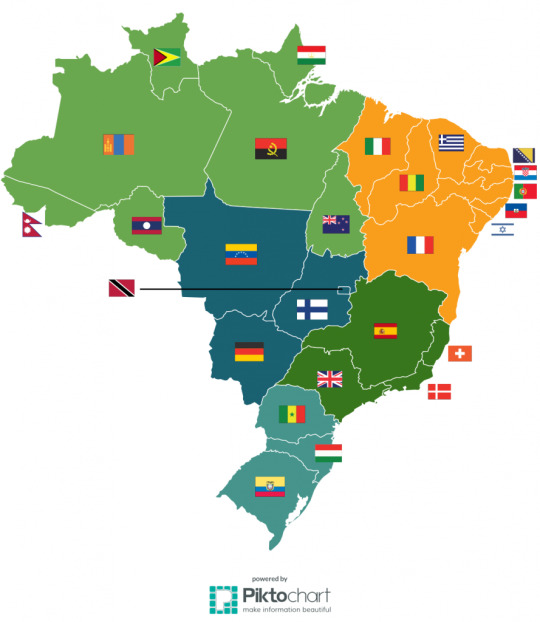
This is particularly relevant to everything I answer further ahead, because since it is so big and so culturally complex anything I say is just going to be a tiny speck compared to different regions.
And besides its size, Brazil had a lot going on colonization and immigration wise - meaning you have regions that have very notable communities from certain countries of the world. A famous example is that, if I recall correctly, we have the biggest japanese settlement of sorts outside of Japan. So that's something!
A funny side effect I can think that relates to this is that in historical novelas (live action television series that air daily and are known for melodrama and intensity) there is always a character that can be roughly described as 'The Sexy Irrevent Italian Immigrant' which is funny lol.
As for my favourite things I think the culinary is definetely a big one!!! There are so many dishes and they are so delicious all the time forever.
Brigadeiros are my favourites from all times, they're this candy made of condensed milk and chocolate powder, thats finished off with sprinkles. It's so yummy, you can also make it into cake filling and a million different things.

I also love Acarajé!! I think properly explaining what they're made off is a bit beyond my english vocabulary but just know its a fried dough that has yummy fillings and shrimp.
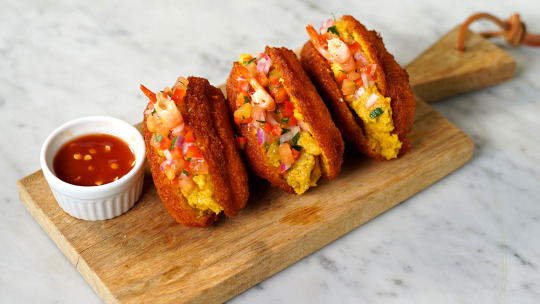
Otherwise I think I also like how warm and friendly people are. There's also this humour in how things are handled and seem which I think it's nice. Again, this is a perception I get from the region I live in, so I'm not sure. Though this is something people here tend to complain about when they go to other countries, so I guess it is at least some sort of significant cultural difference!
Least favourite things are the ever present fear of impeding violence and the blatant social inequality.
Day to day things hmmm. I have no parameter for how it goes out there, but I've heard enough stories that indicate this might be a thing: showering multiple times a day lol. I'm from a hot place so there is that, but this does seem to be a cultural thing as well. Like, I've heard of landlords from other countries complaining of brazilians that use 'too much hot water' because we shower a lot.
Just caring about cleaness a lot in general. Like, again I'm not sure which of these things are cultural outliners but from what I've heard, even things like. You go out, as soon as you go home you take off the 'going out clothes' and shower. And you avoid sitting on the bed sheets with 'going out clothes' etc.
Another thing is that is is very culturally acceptable to be late! To the point where being on time is at times more awkward. Like, say, if a party is said to start at 7 PM, people generally arrive closer to 8PM. I can remember a few birthdays I'd attended as a child where if you arrived 'on time' you'd basically be the only guest present and there would be this awkward air of 'Why Are You Already Here'.
I've also heard we say things we don't mean more? Like half heartedely making plans to go out with a friend or be there a certain day - but its kinda expected that neither side will follow through unless you constantly check up with each other during the days leading to it. I think this steems from a general need to be pleasant and friendly so people don't want to say they won't go or just outright refuse things without coming up with excuses etc.
And at last for tidbits of culture: CHILDREN BIRTHDAY PARTIES FUCKING RULE!!! HARD!!! Even if you're middle class or such it is not uncommon for parties to have trampolines, magicians, clowns, children entertainers etc. A shit ton of decoration, little gifts for the guests to take home (usually cheap toys or candy), themed birthday invitations, themed parties with decorated pannels, a shit ton of candy etc. There's even this sorta common agreement that even if you're bored because you'll be the only adult there, it is fun to attend children birthday parties because you'll eat like a king.
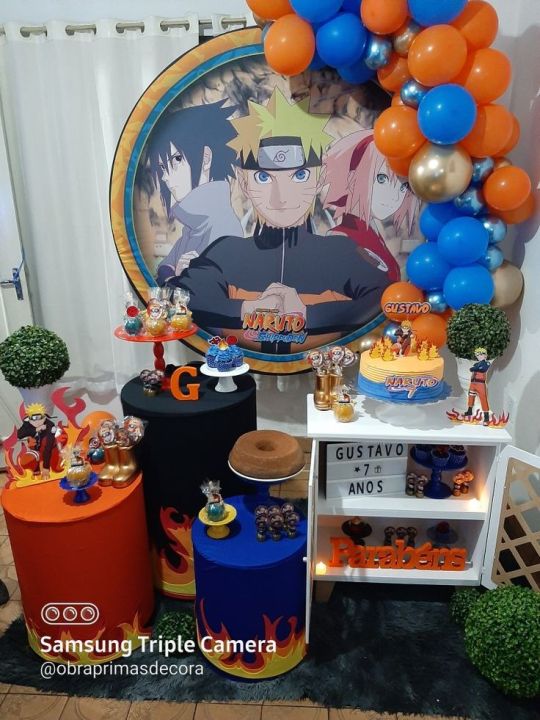
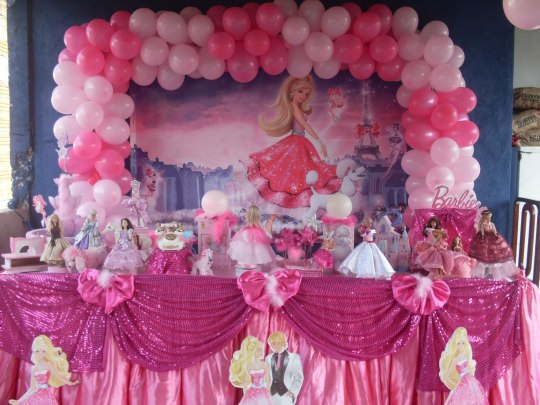
I think thats it!!! I hope that answers it! Thanks for the question :3
167 notes
·
View notes
Note
Hello, my apologies for bothering you.
I believe I may have something interesting related to the Hong Lu is Hong Two theory that you've put forth (and made me a stark believer in). A detail that's incredibly interesting for the whole theory, I believe.
The shadows over every sinner's base EGO seem to show a symbolic representation of some of their trauma. I don't think it's exactly accurate, but it's a symbol of it that is often different in meaning to the sight in their cell's window.
Gregor's has hands reaching towards him, Rodion has nothing discernable because she will tell you she's totally fine, so on so forth. This is a piece of evidence I used at launch to further the theory that Ryoshu is in grief, as her shadow is a butterfly, a symbol of the souls of the departed in several cultures, including Japanese culture.
But I digress, my point is:
Hong Lu's base EGO shadow is an ornate bell. I cannot for the life of me recall if you've already used this tidbit in the theory, and I know it has symbolic importance to Dreams of a Red Chamber, but I don't remember the details exactly, and I vaguely recall it being related to this. I would like to see how your insight can help connect this detail, which feels very important to Hong Lu's character, to the greater theory.
-An avid fan of your insightful perspective.
So this is actually a bit hard for me to answer, as I haven't come anywhere close to finishing DOTRC, nor do I know that much about Chinese culture, so if anyone more knowledgeable would like to contribute, please do!
My current idea (which I know some other people share as well) is that it's some form of a funeral bell. Funeral scenes and death in general are a pretty big part of DOTRC, with Baoyu being one of the characters often shown to be the most impacted by them.
Under the Daiyu Baoyu theory angle, a funeral bell could represent Baoyu's belief that him surviving in Daiyu's body effectively killed them. Within my speculations, the incident that led to them becoming an imperfect "one" is what led to Baoyu running away and taking on a fake persona, thus it would make a lot of sense for that grief and perception of Daiyu's death to cast such a heavy shadow on Hong Lu's E.G.O.
18 notes
·
View notes
Text
[Comic] Immersed in an infinitely long dream
Artist: 橘芝士 (ju zhi shi)
Source: ♡ || Permission: ♡ || Sub-masterlist
⌚ Do not repost ⌚
Warning: NSFW 🔞
Based on Victor’s Melding Into You MQ 🧊

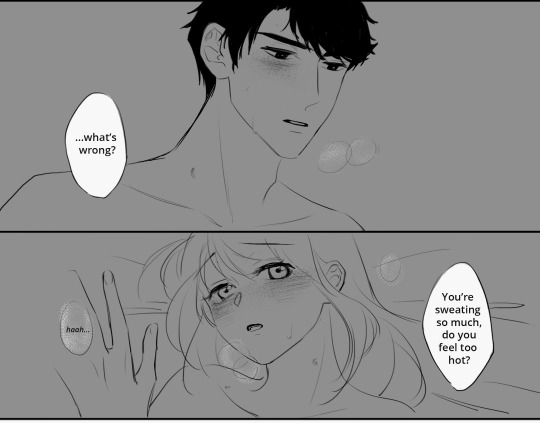


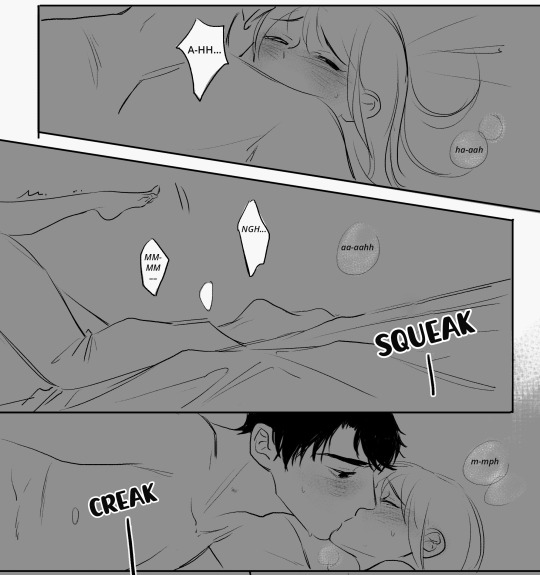
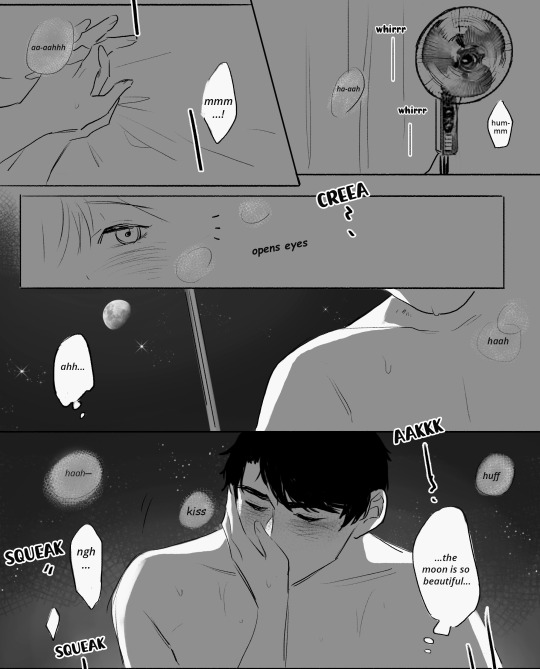
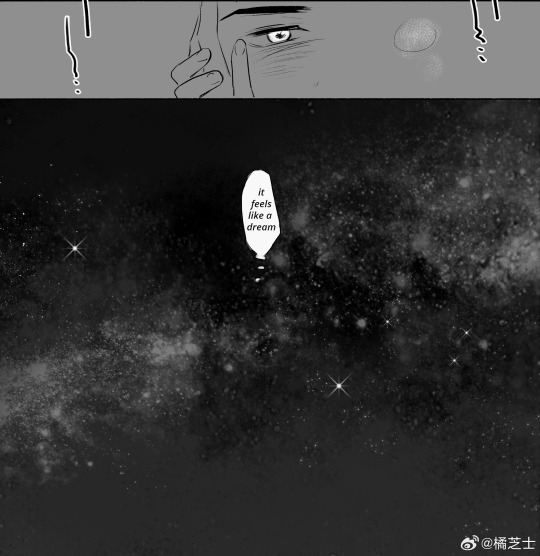
— [Tidbits]:
For those of you who don’t know/ aren’t familiar with the concept– the term “The moon is beautiful/ lovely (isn’t it)”-- is believed to be found by a famous Japanese writer Sōseki Natsume in the 19-20th century. Since the explicit expression of love/ affection wasn’t as widespread in Japanese culture, or it still isn’t in Asian culture in general as compared to the West– the story goes that he instructed his student to translate “I love you” as “The moon is beautiful.” While there isn’t any record validating the story itself, this phrase is now widely used in animes/ dramas as a poetic expression of “I love you,” depicting the wondrous circumstance of falling/ being in love.
—
#ahh i can finally bring this over lmao#GOODBYE WORLD 👋😵💫🫠🧊🔥#p.s. I'll try to get the next two date translations out by next Wednesday and Saturday~ 💕#mlqc victor#mlqc#mlqc li zeyan#mr love victor#mr love queen's choice#李泽言#恋与制作人#love and producer
160 notes
·
View notes
Text
LAWLU SEMI-HC: SUN AND MOON FLOWERS
I write semi-hc simply because its canon that the flowers associated with Luffy and Law are the sunflower and queen of the night respectively
A lot of non-Japanese fans probably already knows this but I'm curious if there are those who are like me that got curious and tried to check the Japanese names for the flowers
For Luffy's sunflowers, it'd be himawari which has the kanji for Sun (日) in it and the flower's literal meaning is 'facing the sun' or 'rotating sun' if I'm not mistaken. I think Oda-sensei might've chosen this flower for obvious reasons in regards to Luffy's bright personality
For Law's, I think Oda-sensei might've chosen the queen of the night because of its many medical properties in asian culture. When I checked its Japanese name, the flower is known as the Gekka Bijin with the word Gekka having the kanji for the Moon (月) in it. For the literal meaning, the flower is known as 'moonlit beauty' I think
So now, it makes me curious if Oda-sensei will use this little tidbit of contrast to LawLu in the series since its apparently canon that they're associated with the sun and the moon
Won't lie, that'd be neat
Anyways, just wanted to share and write out what I found out about the flowers' Japanese names because I didnt expect it but it really is a neat find
Thanks for reading this far!
#lawlu#lawlu headcanon#lawluffy#lawlu headcanons#lawxluffy#law x luffy#one piece#one piece headcanons#lawlu semi headcanons#lawlu semi headcanon#trafalgar d water law#trafalgar d. water law#trafalgar law#one piece law#one piece trafalgar law#op law#one piece torao#op torao#op trafalgar law#monkey d luffy#monkey d. luffy#mugiwara no luffy#strawhat luffy#straw hat luffy#op luffy#one piece luffy#semi headcanons
62 notes
·
View notes